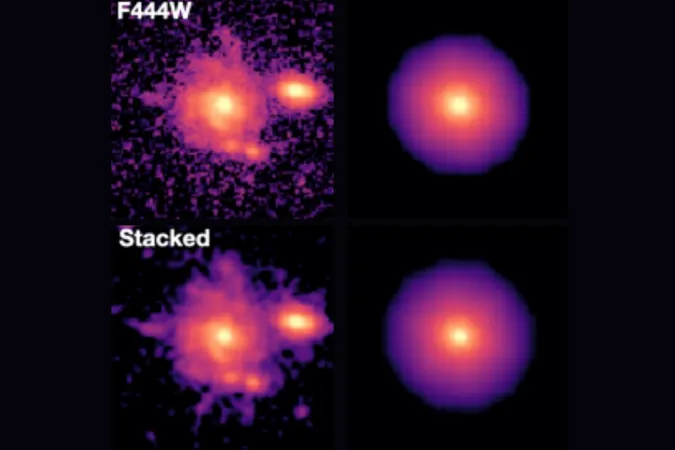
Unveiling Cosmic Giants: Webb Space Telescope Discovers the Most Distant Spiral Galaxies Yet
2024-12-30
Author: Kai
Webb Space Telescope's New Discoveries
As the Webb Space Telescope brings in the New Year with breathtaking cosmic images, it continues to redefine our understanding of the universe. Located a million miles from Earth, Webb's latest discoveries include not one, but two magnificent grand design spiral galaxies—one of which may hold the title of the most distant spiral galaxy ever observed.
The Distant Galaxies
Researchers have extensively studied these colossal galaxies, with findings published on arXiv. The first galaxy, A2744-GDSp-z4, and a second even more distant one, named Zhúlóng—after a dragon deity from Chinese mythology—are both remarkable examples of grand design spiral galaxies, characterized by their well-defined arms. This type of galaxy is distinct from flocculent spiral galaxies, which have less distinct structures. To put it into perspective, our own Milky Way is classified as a barred spiral galaxy, illustrating the variety that exists in the cosmos.
A2744-GDSp-z4
A2744-GDSp-z4, depicted in stunning color in Webb's images, boasts an estimated mass of around 14 billion solar masses. Its surprisingly intricate structure hints at the sophistication of galactic formation in the early universe, existing merely 1.5 billion years after the Big Bang. This discovery suggests that well-defined spiral galaxies were forming much earlier than previously thought. Despite the faintness of its spiral arms, observers can still discern its general shape, particularly in the composite images showcasing the galaxy's location within the galaxy cluster Abell 2744.
Zhúlóng
Zhúlóng, portrayed in vibrant pink in the images, has been labeled as “the most distant bulge-disk galaxy with spiral arms known to date.” With a mass comparable to that of the Milky Way, it stands out for its relatively low star formation rate—approximately 66 solar masses per year—an observation that ties into earlier data showing that ancient galaxies were generally poor in metals yet rich in gas. This raises intriguing questions about the conditions necessary for star formation in such early cosmic epochs, suggesting that despite its size, Zhúlóng may have lacked the necessary ingredients for a more rapid star formation process.
Gravitational Lensing
The breathtaking images brought forth by Webb are part of the telescope's deployment of gravitational lensing—a technique that utilizes the bending of light due to intense gravitational fields in the universe. This effect not only magnifies the light from distant galaxies but also allows astronomers to study these objects in detail, even though they appear pixelated due to their immense distance.
Comparative Imaging
While the grand design spirals remain distant and fuzzy, closer galaxies captured by Webb showcase remarkable detail—an indication of the telescope's tremendous capabilities. A side-by-side image comparison reveals the stark difference in clarity: the left side features data from Webb's Near-Infrared Camera (NIRCam), highlighting warmer light from newly birthed stars, while the right side displays images captured by MIRI, the telescope’s mid-infrared imager, focusing on cooler light emitted by dust and gas.
Future Exploration
As Webb pushes the boundaries of what we know about the universe and unveils its secrets, astronomers are only beginning to scratch the surface of cosmic exploration. These discoveries will undoubtedly spark further inquiry and reshaping of theories regarding galaxy formation and evolution in the vast and ancient cosmos. Stay tuned as Webb continues to delve deeper into the wonders of our universe, revealing spectacles that defy our imagination and understanding!

 Brasil (PT)
Brasil (PT)
 Canada (EN)
Canada (EN)
 Chile (ES)
Chile (ES)
 Česko (CS)
Česko (CS)
 대한민국 (KO)
대한민국 (KO)
 España (ES)
España (ES)
 France (FR)
France (FR)
 Hong Kong (EN)
Hong Kong (EN)
 Italia (IT)
Italia (IT)
 日本 (JA)
日本 (JA)
 Magyarország (HU)
Magyarország (HU)
 Norge (NO)
Norge (NO)
 Polska (PL)
Polska (PL)
 Schweiz (DE)
Schweiz (DE)
 Singapore (EN)
Singapore (EN)
 Sverige (SV)
Sverige (SV)
 Suomi (FI)
Suomi (FI)
 Türkiye (TR)
Türkiye (TR)
 الإمارات العربية المتحدة (AR)
الإمارات العربية المتحدة (AR)